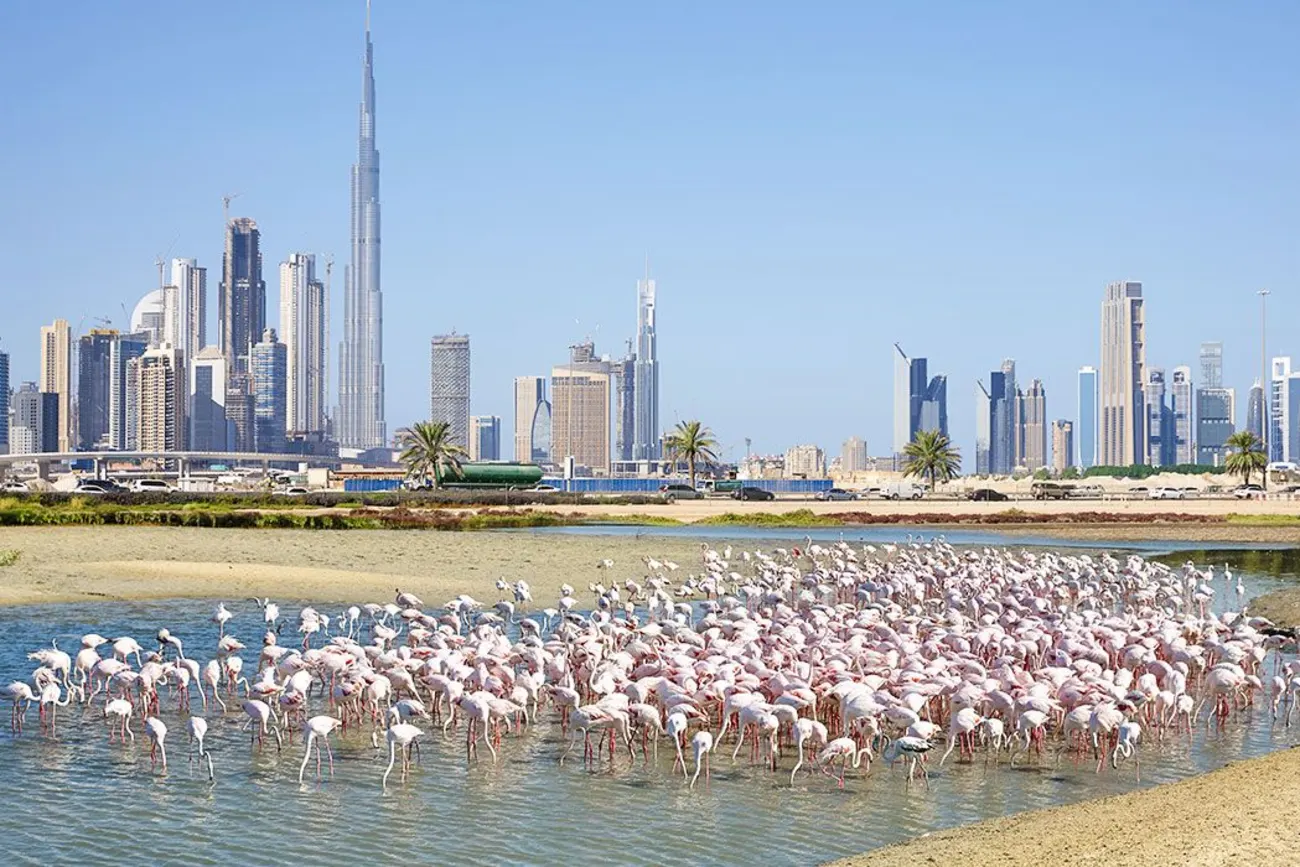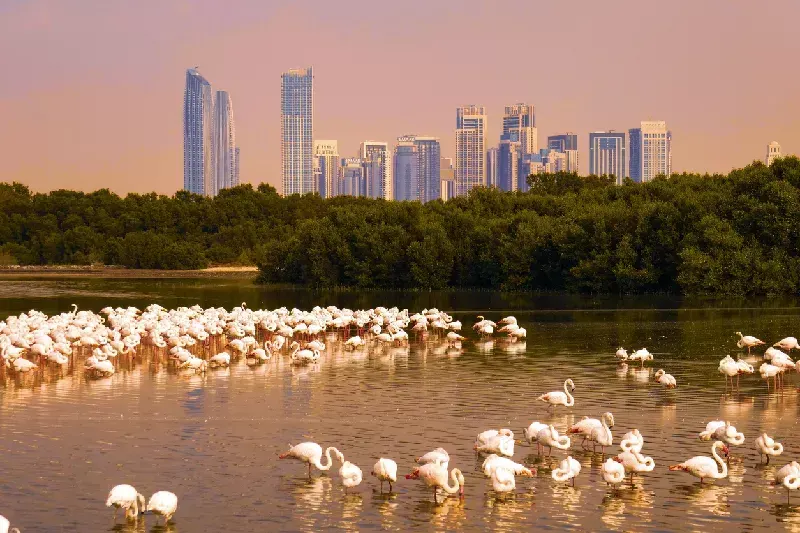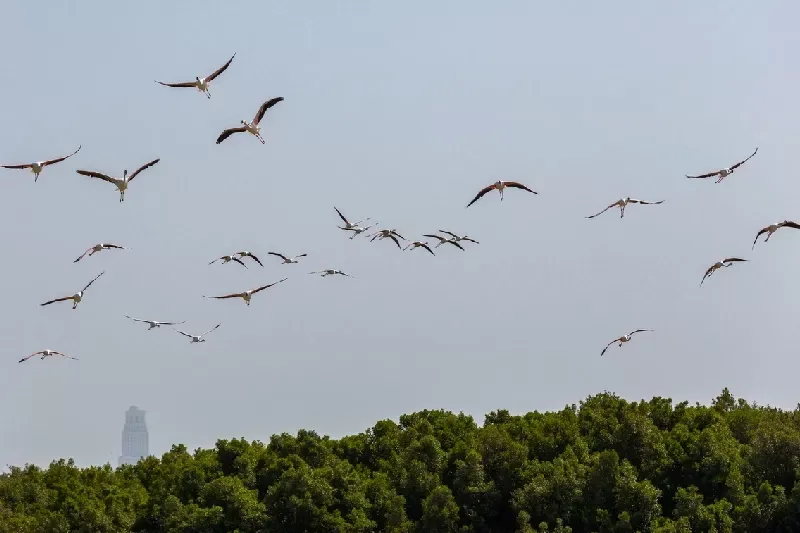Ras Al Khor Wildlife Sanctuary
Ras Al Khor Wildlife Sanctuary offers a serene escape with flamingos, wetlands, and diverse birdlife in the heart of Dubai. A must-visit for nature lovers!

Dubai's urban tapestry holds a precious natural gem - the Ras Al Khor Wildlife Sanctuary. Spanning 10.13 square kilometers, this untouched wetland kingdom is nature's great stage where 472 species of wildlife and 47 varieties of vegetation thrive, attracting inquisitive minds from more than 100 nations annually.
The sanctuary extends grandly at the mouth of Dubai Creek, where urbanity and wilderness meet in seamless unison. Here, great flamingos provide dramatic silhouettes against Dubai's glittering skyscrapers, their lithe bodies stretching to 1.5 meters. These stunning birds, combined with thousands of winged tourists from African coastlines, make the sanctuary a wildlife extravaganza during winter seasons from November to March.
Discover the best spots and pick up useful information for a worthwhile experience in this open-to-the-public natural sanctuary. This guide uncovers great viewpoints and interesting facts to enhance your Dubai trip to this freely visitable wilderness retreat.

Discovering Ras Al Khor Wildlife Sanctuary
A verdant jewel on the Dubai Creek shores, Ras Al Khor Wildlife Sanctuary covers more than 6.2 square kilometers of thriving wetland. Ramsar Convention status in 2007 for the sanctuary gave it the title of the UAE's first international importance wetland.
Location and layout
The sanctuary graces the eastern edge of Dubai Design District, abutting Al Jadaff. Living up to its Arabic name 'The Cape of the Creek', this natural haven holds a dominant position at the entrance to Dubai Creek. Nature's masterpiece unfolds in a captivating mosaic of salt flats, intertidal mudflats, mangroves, and lagoons - each creating distinctive havens within the haven.
Birds you can expect to see
Life abounds richly in these sheltered realms - 472 forms of wildlife perform to the rhythm of 47 types of flora. Winter makes this city haven a breathtaking congregation of birds, harboring over 25,000 birds from 201 bird species. Common winged residents are:
- Asian pied myna
- Black-winged stilt
- Caspian tern
- Gray heron
- Osprey
- Western heron
With the exception of the feathered visitors, the reserve is home to 13 mammal species, 14 reptile species, and 52 fish species. Winter brings with it special visitors - broad-billed sandpipers soar along with great spotted eagles, with Pacific golden plovers gracing this urban wilderness.
Best viewing spots
Three well-placed bird hides are windows to this world:
- Mangrove Hide: With eye-level sightings of emerald mangrove forests, this vantage point has privileged views of migrant ducks, Eurasian spoonbills, and kingly raptors.
- Flamingo Hide: The crowning glory of vantage points, where visitors witness the sanctuary's renowned pink flamingos in all their splendor.
- Lagoon Hide: Bird-watchers' paradise, this viewpoint is perhaps the best spot to view waders and raptors gliding creek waters.
Dubai Municipality is the custodian of this natural treasure, maintaining these hides open along with preserving the delicate ecological balance. These hides are accessible to visitors free of charge - winter hours are from 7:30 am to 5:30 pm, while summer months (April to September) are from 6:00 am to 6:00 pm.
Month-by-Month Flamingo Guide
Winter colors Ras Al Khor Dubai in soft pink hues as flamingos visit in awe-inspiring flocks. Nature puts on its biggest show between the months of November and March when these lovely birds convert the wetland into its temporary home. A Dubai tour during this time is an experience of a lifetime as one gets to enjoy this beautiful view so near since one can also explore the city's rich combination of nature and modern attractions.
Peak season
Winter's mild kiss brings flamingos in spectacular quantities, with surveys carried out by scientists counting over 3,000 greater flamingos. Such amazing birds illustrate the beauty of nature in their many hues of pink, with every color providing testimony to their carotenoid diet.
Dawn's early light summons these skinny beasts to their breakfast banquet at 9:00 AM, though winter's chill might cause them to be late. Afternoon sun ushers in another summons at 3:00 PM, when the light is perfect for photographing their otherworldly beauty.
Off-peak season
Summer temperatures thin out the flamingo population, but around 1,000 devoted residents color the waters of the sanctuary pink. Although their numbers are fewer, these resilient birds show remarkable adaptation to rising temperatures. Tourists observe this spectacle between 6:00 AM and 6:00 PM during these warmer months.

Customize Your Dream Vacation!
Get in touch with our local experts for an unforgettable journey.
Plan Your TripBest Times of Day for Viewing
Nature offers various rhythms during the day at Ras Al Khor Dubai. Each hour of daylight offers various perspectives of these incredible creatures, treating diligent observers to marvelous moments.
Morning feeding time
Sanctuary personnel coordinate the first feeding ceremony of the day at between 9:00 and 10:00 AM. Birds glide just inches from the mangrove water to forage for food and present an astounding show of wild instincts. The earliest birds can enjoy opening the gates at 7:30 in winter and in summer it starts opening at 6:00 AM, a great time to see the sanctuary bustling.
Evening golden hour
Dusk makes the sanctuary a photographer's paradise. Sunlight's final waltz encircles the wetlands in golden color, creating perfect light for capturing nature's poetry. The second feeding ceremony begins at about 4:00 PM, drawing endless winged inhabitants to their dinner gathering.
Midday viewing tips
The 10:00 AM to 4:00 PM period shows steady streams of feeding activity. Veteran observers recommend:
- Coordinating visits during low tide to see wading birds' fishing forays near mangroves
- Finding refuge in viewing hides for intimate wildlife encounters without disturbing their natural habits
- Bringing binoculars to reveal subtle details of avian behavior
Astute visitors spend 1-2 hours immersed in the sanctuary's treasures. The Mangrove Hide welcomes especially those seeking perfect photographic moments.
Planning your Visit to Ras Al Khor
The natural attractions of the sanctuary reward visitors who arrive well-prepared. As nature's rhythms invite tourists all year round, meticulous planning turns trips into memorable experiences with wildlife.
Getting There
Dubai's sophisticated infrastructure weaves into seamless trips to this nature sanctuary. The sanctuary provides ample free parking for motorized travelers. Two primary routes guide visitors to their destination:
- By Car: Travel through Sheik Zayed Road/E11 to Al Meydan Road/D69, along the route of exit 47 to Al Khail Road/E44
- By Public Transport: City buses pass through the sanctuary
What to bring
Nature shares her secrets with those who come prepared. The absolute necessities for your stay are:
A) Photography Equipment:
- Camera with telephoto lenses
- Memory cards to capture thousands of seconds
- Day's worth of charged batteries for discoveries
B) Viewing Essentials:
- Binoculars to reveal distant mysteries
- Bird and nature guide for curious minds
- Reusable water bottle
C) Fashion Considerations:
- Clothing appropriate to nature's embrace
- Close-toe shoes
- Simple clothing in respect of UAE cultures
Sacred guidelines protect this fragile ecosystem. View points are food- and drink-free. For photography enthusiasts, silence mode should be adopted with regard to places devoid of flashes. Visiting Ras Al Khor Wildlife Sanctuary is among the top things to do in Dubai.
Ras Al Khor Wildlife Sanctuary glows as Dubai's jewel of natural preservation, where city grandeur and natural beauty sway in unison. This unforgettable world welcomes wildlife enthusiasts to witness nature's grand show, where flamingos paint the wetlands pink against the city's silver skyline.
The sanctuary's mysteries are unveiled only to those who come equipped with patience and the right tools. Three strategically placed hides are windows into this untamed domain, each providing distinctive views of nature's drama. Summer may mute the flamingo song, but the spirit of the sanctuary is lively year-round, providing haven for wildlife as well as city-fatigued souls in need of nature's comfort within the urban landscape of Dubai.
There are Many More Things to Do in Dubai, Inquire Now and Plan Memorable Dubai Tours!
Ras Al Khor Wildlife Sanctuary is a protected wetland reserve in Ras Al Khor Dubai, spanning over 6.2 square kilometers. Recognized by the Ramsar Convention, this ecological haven is home to diverse wildlife, including thousands of migratory birds, making it a must-visit for nature lovers.
The best time to witness the spectacular flamingo gatherings at Ras Al Khor Wildlife Sanctuary is during winter, from November to March. These graceful birds congregate around the Flamingo Hide, especially during feeding sessions around 10:00 AM and 4:00 PM.
Ras Al Khor Dubai shelters over 200 bird species, including the iconic greater flamingos, ospreys, grey herons, Caspian terns, and black-winged stilts. Seasonal visitors include the broad-billed sandpiper and Pacific golden plover, making it a paradise for birdwatchers.
Visiting Ras Al Khor Wildlife Sanctuary is completely free of charge. Guests can explore the three bird hides and observe the stunning wildlife without an entry fee.
In Arabic, "Ras Al Khor" translates to "Cape of the Creek", referring to its strategic location along Dubai Creek, where freshwater and saltwater ecosystems converge to create a rich biodiversity hotspot.

























































